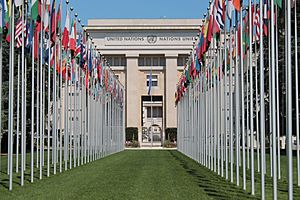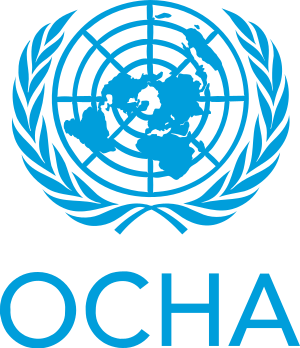Extreme poverty facts for kids
Extreme poverty is the most serious kind of poverty. It means people do not have enough of the very basic things they need to live. This includes not having enough food, safe drinking water, clean places to go to the bathroom, healthcare, a safe home, education, or even information.
The United Nations (UN) describes extreme poverty as a situation where people are missing many basic human needs. It's not just about how much money someone earns. It's also about whether they can get important services like schools or hospitals.
As of 2018, extreme poverty usually means living on less than $1.90 per day. This amount is set by the World Bank and is called the international poverty line. This is like living on less than $1.00 a day back in 1996. Most people living in extreme poverty are in South Asia and Sub-Saharan Africa. In 2018, Nigeria had the most people living in extreme poverty, with about 86 million.
In the past, most people in the world lived in extreme poverty. For example, in 1800, over 80% of the world's population was extremely poor. By 2015, this number dropped to less than 20%. The UN estimated that in 2015, about 734 million people (or 10% of the world) were still in this situation. This number was much higher in 1990 (1.9 billion) and 2008 (1.2 billion). This shows huge progress in fighting extreme poverty around the world.
Even with this progress, many people still think extreme poverty has not gone down. This is often seen in surveys around the world.
Reducing extreme poverty and hunger was the first big goal of the Millennium Development Goals (MDGs). These goals were set by the United Nations in 2000. The aim was to cut extreme poverty in half by 2015. This goal was actually met five years early! Now, the Sustainable Development Goals aim to end extreme poverty completely by 2030. Many international groups, including the UN and the World Bank, are working towards this goal.
Contents
Regions Affected by Extreme Poverty
Percent of extreme poverty by region(2017) Sub-Saharan Africa (62.1%) South Asia (24.85%) East Asia & Pacific (4.19%) Middle East & North Africa (3.47%) Latin America & Caribbean (3.4%) Developed Countries (1.07%) Europe & Central Asia (0.19%)
The table below shows how many people in different parts of the world lived on less than $1.90 a day. You can see how these numbers have changed over the years.
| Region | 1990 | 1995 | 2000 | 2005 | 2010 | 2015 | 2017 |
|---|---|---|---|---|---|---|---|
| Developed Countries | 4.06 | 4.99 | 4.7 | 5.48 | 5.28 | 7.91 | 7.45 |
| Latin America & Caribbean | 66.61 | 64.75 | 65.77 | 54.04 | 35.3 | 22.95 | 23.73 |
| Middle East & North Africa | 14.8 | 16.49 | 9.95 | 9.6 | 6.86 | 15.74 | 24.16 |
| South Asia | 557.05 | 550.44 | 564.92 | 533.28 | 425.32 | 230.51 | 173.1 |
| East Asia & Pacific | 977.29 | 766.14 | 632.26 | 347.99 | 212.12 | 42.08 | 29.15 |
| Europe & Central Asia | 11.51 | 32 | 34.28 | 22.04 | 11.27 | 7.35 | 6.37 |
| Sub-Saharan Africa | 280.95 | 352.76 | 388.27 | 393.57 | 412.49 | 417.6 | 432.5 |
| Total | 1,910 | 1,790 | 1,700 | 1,370 | 1,110 | 744.14 | 696.45 |
Organizations Helping to End Extreme Poverty
Many groups around the world are working hard to end extreme poverty. Here are some of the main ones:
The World Bank Group
The World Bank Group (WBG) is a big organization that helps countries develop. In 2013, they set two main goals. The first goal is to end extreme poverty by 2030. This is the same goal as the UN. They also want to reduce extreme poverty to less than 9% by 2020.
Their second goal is to help the poorest 40% of people in a country grow. This means they want to make sure that when a country's economy grows, it helps the people who need it most. This way, growth helps lift people out of poverty and doesn't make the gap between rich and poor even bigger.
The World Bank focuses on helping economies grow. They support programs that train people for jobs, help small businesses start, and create fair labor laws. They also work with countries to understand why some people are poorer than others. Then, they suggest changes to public policies to make things more fair for everyone.
The World Bank also helps with nutrition, money transfers, and transportation. They know that children who don't get enough food when they are very young can have health problems later. This can trap them in poverty. So, they work with groups like UNICEF to make sure young children are well-fed. They also give money to poor families who meet certain rules, like making sure their children go to school or get healthcare. Finally, they help build better roads and public transport. This helps people in rural areas get to hospitals and find better jobs.
The United Nations
The United Nations has many different parts that work to fight poverty.
UN Office for the Coordination of Humanitarian Affairs (OCHA)
The United Nations Office for the Coordination of Humanitarian Affairs (OCHA) helps organize all the different groups working to fight poverty and help in disasters. They make sure that aid efforts are clear and effective. They send special teams to disaster areas to help coordinate the international response.
UNICEF
The United Nations Children's Fund (UNICEF) was first created after World War II to help children in Europe. Now, UNICEF helps children in extreme poverty in over 190 countries. They work to help children overcome problems like poverty, violence, disease, and unfair treatment. Their main goals include helping children survive and grow, getting them basic education, fighting HIV/AIDS, and protecting children.
UN Refugee Agency (UNHCR)
The UN Refugee Agency (UNHCR) helps protect refugees around the world. Refugees are people who have had to leave their homes because of war or danger. UNHCR makes sure these people have the right to find safety in another country. They also help them return home, settle in a new place, or move to a third country. UNHCR works in over 125 countries and helps millions of people.
World Food Programme (WFP)
The World Food Programme (WFP) is the biggest organization that fights hunger globally. They provide food to more than 90 million people in 75 countries each year. WFP not only helps people get food now, but also helps communities become stronger so they can grow their own food in the future. They are experts in understanding food needs, providing good nutrition, buying food, and getting it where it needs to go.
World Health Organization (WHO)
The World Health Organization (WHO) leads global health efforts. They help decide what health research is needed and create health policies based on facts. They also fight diseases that are common in poor areas, like HIV/AIDS, malaria, and tuberculosis. WHO also works on important issues like making sure drinking water is safe and helping mothers and newborn babies stay healthy.
See also
 In Spanish: Pobreza extrema para niños
In Spanish: Pobreza extrema para niños
- List of countries by percentage of population living in poverty
- Income inequality metrics
- Least developed countries
- Poverty threshold
- Poverty reduction
- Millennium Development Goals
- Sustainable Development Goals
Images for kids









